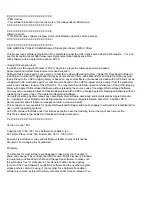
Management
108
Terminal Server User Guide, Version 3.3
Advanced
Overview
Review the configuration options in the Advanced page to determine if any of them apply to your
implementation.
Login Tab Field Descriptions
Configure the following parameters:
Internet Address
The IP address of the SNMP manager that will send requests to the Terminal
Server. If the address is
0.0.0.0
, any SNMP manager with the
Community
Name
can access the Terminal Server.
Permissions
Permits the Terminal Server to respond to SNMP requests.
Data Options:
z
None
—There is no response to requests from SNMP.
z
Readonly
—Responds only to Read requests from SNMP.
z
Readwrite
—Responds to both Read and Write requests from SNMP.
Default:
None
Read-Write User
Specified user can view and edit SNMP variables.
Read-Only User
Specified user can only view SNMP variables.
Trap
The trap receiver is the network management system (NMS) that should
receive the SNMP traps. This NMS must have the same SNMP community
string as the trap sender.
Internet Address
Defines the hosts (by IP address) that will receive trap messages generated by
the Terminal Server. Up to four trap hosts can be defined.
Use System Name
in Prompts
Displays the
System Name
field value instead of default product name. When
enabled, the
Server Name
is displayed in the Terminal Server login prompt,
CLI prompt, WebManager login screen, and the heading of the Menu.
Default:
Disabled
Display Login
Banner
This parameter concerns the banner information (product name/software
version). This banner information is presented to a user with a login prompt.
For security reasons, you can turn off the display of this information.
Default:
Disabled
Use Custom Login
Prompt
When set, and a custom language file is in use, the login prompt will use the
string defined in the language file as the login prompt instead of the default
prompt,
login:
.
Default:
Disabled
















































